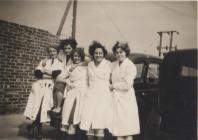Mair Griffiths. Voices from the Factory Floor
Items in this story:
Mair confirmed her name, address and date of birth - 14/07/1932.
Mair’s father was a farmer and she was one of 7 children. The farm was sold on her father’s death. Some of Mair’s sisters worked in a sewing factory. She went to school in Llangefni and left aged 16 to look for work. She wanted to be a nurse but had to wait until she was 19. She learnt to type in the British School, was interviewed for a job in the milk factory and was successful. This was in 1949 – in 1966 the factory let go a number of married women, and Mair along with them. She was shocked and received no sort of compensation.
Whilst working there, Mair learnt how to test the milk. Her first wage was £1, 12s and 6d, most of which she gave to her mother. She lived in Bodffordd and travelled by bus to the factory in Llangefni. At one time she worked the night shift and bought a bicycle to get to work. Initially she worked from 9-5 and didn’t find the hours long. There were breaks at 10, lunchtime and a tea-break at 3. There was no canteen, just a table where the workers hanged their coats. The tea water was heated in the lab. Mair took sandwiches every day until they built a canteen.
8.30 There were six girls working at the factory when Mair started – all single girls. Every day, lorries brought milk in churns from outlying farms which was tested by the girls in the lab. The girls worked in pairs, one to take a sample from the churn, the other to note the farms’ names. The milk was then taken to the lab to test the butterfat. The churn was then emptied into a larger vat. Mair describes the testing process – opening the churns, stirring the milk, smelling it; if it was sour a sample was placed in an incubator overnight. The test results didn’t take too long to come through. If all was well, it was bottled; if not, it was returned to the farmer who’d receive no payment for it. Sometimes the girls found foreign bodies in the milk – a piece of meat or even curlers when the farmer’s wife had a perm. The farmer was usually notified of this by phone from the office or he might receive a letter if the churns were too light. If his milk was returned too often (e.g. for sourness) the farmer would complain to the girls in the lab.
17.00 The girls in the lab worked with acid and wore overalls but they didn’t always wear the required gloves even though they were supervised. They were supposed to wear wellingtons when going out to collect samples. The factory was very clean as it was constantly washed by the men. The bottles were washed and sterilised – placed in a centrifuge and an oven. Mair thought the managers were very good – especially Mr R Thomas who died in his office directly after finishing work at five o’clock one day. Mair remembers there being about a dozen girls between the lab and the office where the wages were done. There were a lot of men. Most of the workers spoke Welsh with the odd Englishman – but the lab workers were all Welsh.
When Mair left the factory in 1966 her wages had risen to £11.30. Some of her colleagues (Eirlys, Maggie and Helen) were sent to college to learn more about the work. Nobody wondered why some were chosen and some weren’t. Mair was grateful to have a job.
Mair cannot recall a workers’ union at the factory, even though Rosie (VN032) remembers that only the men had a union. Mair lost her job when there was a drop in the amount of milk supplying the factory – two girls were lost from the office: Mair and Eirwen. The manageress in the office wrote to Head Office on their behalf. The official reason for choosing them both was because they were married. Mair had no choice other than to believe that this was the real reason and that the policy was to lose women before using the last in first out rule. Had there been a union for the women, perhaps it could have fought Mair’s case. She was given 5 weeks’ notice and then drew the dole which was £4/week. Previously, women had been able to go to the front of the dole queue, but this was no longer the case. There were many unemployed at the time, but Mair found work in a shop for the winter.
31.00 The fact that the men at the factory were in a union but the women were not was never discussed. The letter to Head Office written by Mrs Thomas had no effect and there was a stoic acceptance of the way things were. Mair had married in 1958 – her husband drove a milk lorry for the factory, but they had no children. As she worked her 5 weeks’ notice, Mair was downhearted and angry, but none of the other girls mentioned the subject of her leaving as it was dangerous to speak out in those days. There was no farewell party but the other girls bought her a present. Mair didn’t work a night shift for very long – and that came to an end before she was married. Mair recalls an incident that happened one evening at work. During her hour break she went down to a club in Llangefni to see who was there and to watch people dancing. When she returned to work the manager was waiting for her at the door. He asked her where she’d been and wasn’t happy about the situation. Mair had no choice but to do a night shift back then although she can’t remember whether she was paid more for doing so.
Once married, Mair lived in Llangaffo but didn’t leave the house much and spent her time doing housework. She can’t recall her annual holiday allowance although the factory didn’t close for a fortnight over the summer because cows had to be milked and milk produced. Bank holidays didn’t affect them either. Mair used to go to the Eisteddfod during her holidays.
In 1958, she went on a factory outing to Bourneville when it was still owned by Cadbury's.
Duration: 40 minutes








